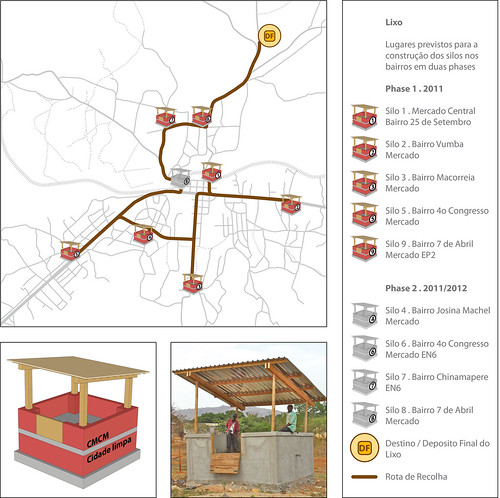
Planning a public system for waste management
Planning of a first simple system for proper garbage collection and a central waste deposit in the City of Manica. In two phases eight decentralized garbage collection points are built near the urban submarkets. These are made from local materials.
Central places in the city
For the first step towards a systematic waste disposal, sites are to be found as a central point for the initial development of such a system. This will ensure that as many people within the city area can learn and benefit from this system. As a central place in the local neighborhoods, markets are identified. This neighborhood markets are places that are known to all and which are most frequented and where large quantities of waste is being generated. In addition, generally the primary school of each district is located in close proximity to each of these markets. The public education at this health issue can be practiced locally. Moreover, the informal dangerous waste disposals in the markets (and thus also in the schools!) are eliminated.
Construction and implementation
The project was derived as the first urban construction project directly from the outcomes of the PEU Plano da Estrutura Urbana (master plan). First, in the overall urban scale, the current hot spots in the field of informal garbage dumps were located. This information has been overlaid with other geographic data. (Schools, markets, rivers and streams, etc.)
From this information, the first eight public sites for future waste collection points are derived. In the implementation of the project the experiences from the municipality of Inhambane in this area of work were used. The design was adapted to local conditions. As in Inhambane the design of the construction based on the knowledge and experience of local craftsmen. Thus, the possibility of a maintenance and repair of all components is assured in the future.
map and grafics: Georg Jahnsen in collaboration with the Municipality of Manica.
Planung eines öffentlichen Systems zum Müllmanagement
Planung eines ersten einfachen Systems zur fachgerechten Müllsammlung und zentralen Mülllagerung im Munizip Manica. In zwei Phasen sollen insgesamt acht dezentrale Müllsammelstellen im Bereich der Stadtteilmärkte entstehen. Diese werden aus lokalen Materialien hergestellt.
Zentrale Orte im Stadtgebiet
Für den ersten Schritt hin zu einer systematisierten Abfallbeseitigung sollen zentrale Orte als Initialpunkte zum Ausbau eines solchen Systems gefunden werden. So wird sicher gestellt, dass möglichst viele Menschen innerhalb des Stadtgebiets von diesem System erfahren und profitieren können. Als zentrale Orte in den dezentralen Stadtvierteln werden die Märkte ausgemacht. Diese Stadtteilmärkte sind Orte, die allen bekannt sind, die am meisten frequentiert sind und an denen grosse Mengen Abfall anfallen.
Zudem befindet sich in direkter Nähe zu jedem dieser Märkte in der Regel die jeweilige Grundschule des Stadtviertels. So kann der Aspekt der öffentlichen Aufklärung zu diesem Gesundheitsthema direkt vor Ort praktiziert werden. Ausserdem werden die gefährlichen informellen Müllabladestellen im Bereich der Märkte (und damit auch im Bereich der Schulen!) beseitigt.
Konstruktion und Durchführung
Das Projekt wurde als erstes städtisches Konstruktionsvorhaben direkt aus den Erkenntnissen des PEU Plano da Estrutura Urbana (Masterplan) abgeleitet. Zunächst wurden im gesamtstädtischen Massstab die heutigen Gefahrenpunkte im Bereich der informellen Müllhalden verortet. Diese Informationen wurden mit anderen geografischen Daten überlagert. (Schulen, Märkte, Flüsse und Bäche etc.) Aus diesen Informationen konnten die zukünftigen Standorte für zunächst acht öffentliche Müllsammelpunkte abgeleitet werden.
Bei der Durchführung des Projektes wurde auf die Erfahrungen des Munizips Inhambane in diesem Bereich zurückgegriffen. Die Konstruktion wurde den hiesigen Gegebenheiten angepasst. Wie auch in Inhambane wurde auf eine Konstruktion Wert gelegt, die auf dem Wissen und den Erfahrungen der Handwerker vor Ort beruht. So ist die Möglichkeit einer Instandhaltung und Reparatur aller Bauteile in Zukunft sicher gestellt.
Karte und Grafiken: Georg Jahnsen in Zusammenarbeit mit dem Munizip der Stadt Manica
Planeamento dum sistema público de gestão de resíduos
Planeamento dum primeiro sistema simples para coleta de lixo adequada e um depósito de resíduos central na cidade de Manica. Em duas fases oito pontos de coleta descentralizada de lixo são construídos perto do submercados urbanos. Estes são feitos de materiais locais.
Lugares centrais da cidade
No primeiro passo para o desenvolvimento inicial lugares centrais encontram-se para uma eliminação de resíduos sistemática. Isso irá garantir que muitos pessoas dentro da área da cidade podem aprender e beneficiar deste sistema. Como um lugar central nos bairros, os mercados estão identificados. Estos mercados de bairro são os lugares que são conhecidos por todos e que são mais frequentados e onde grandes quantidades de resíduos está gerado.
Além disso, geralmente a escola primária de cada bairro está localizado nas proximidades de cada um desses mercados. A educação pública neste problema de saúde pode ser praticado localmente. Além disso, o informal eliminação de resíduos perigosos nos mercados (e, portanto, também nas escolas!) são eliminados.
Construção e implementação
O projeto foi elaborado como o primeiro projeto de construção urbana diretamente nos resultados do PEU Plano da Estrutura Urbana. Primeiro, na escala global urbano, os pontos quentes atuais no campo da lixões informais foram localizados. Esta informação foi sobreposto com outros dados geográficos. (Escolas, mercados, rios e riajos, etc) A partir desta informação, os oito primeiros locais públicos são derivados para os pontos de coleta de resíduos futuro.
Na implementação do projeto as experiências do município de Inhambane nesta área de trabalho foram utilizados. O projeto foi adaptado às condições locais. Como em Inhambane o projeto de construção baseado no conhecimento e experiência dos artesãos locais. Assim, a possibilidade de uma manutenção e reparação de todos os componentes é assegurada no futuro.
Mapas e gráficas: Georg Jahnsen em collaboração com os Municípios de Manica e Catandica